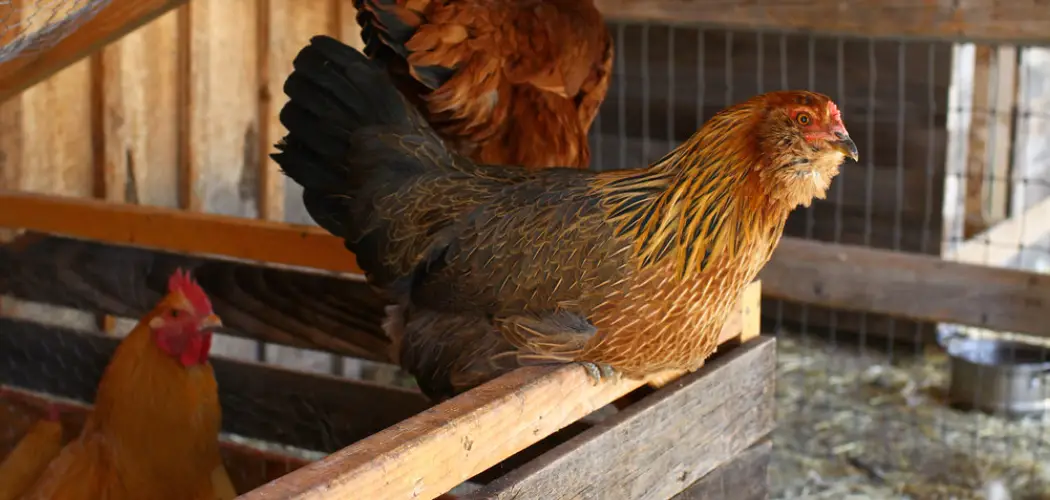When raising chickens, it is important to provide them with a safe and comfortable living environment. One aspect of this is ensuring that they have suitable perches to roost on at night. Not only do perches give chickens a place to rest and sleep, but they also help keep them warm by lifting them off the cold ground. In this guide, we will go over the steps on how to make perches for chickens.
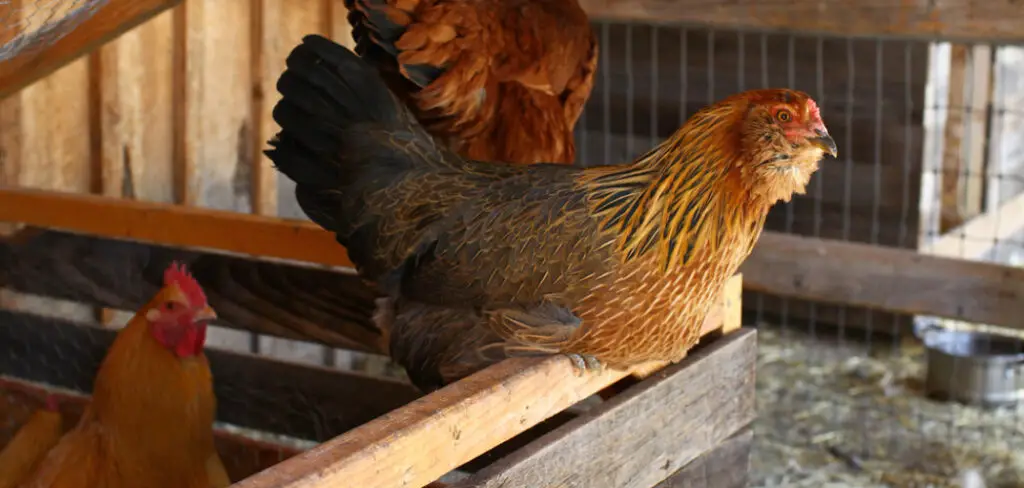
Materials Needed
To make perches for your chickens, you will need the following materials:
- Wooden boards or branches
- Saw
- Screws or nails
- Drill (optional)
It is important to use untreated wood when making perches for chickens, as treated wood can be harmful to their health.
What are Perches for Chickens?
Perches for chickens are essentially raised platforms or bars that they can rest on at night. These perches mimic their natural roosting behavior in the wild, where chickens would sleep on tree branches to stay safe from predators. In addition, perches also provide chickens with a sense of hierarchy within the flock, as higher-ranking chickens will often claim the highest perch.
12 Steps on How to Make Perches for Chickens
Step 1: Measure the Coop
Before you begin constructing perches for your chickens, it is important to measure the interior of your coop. This will help determine how many perches you will need and what size perches you will need. And remember, chickens like to roost close together, so plan for enough space for all of your birds.
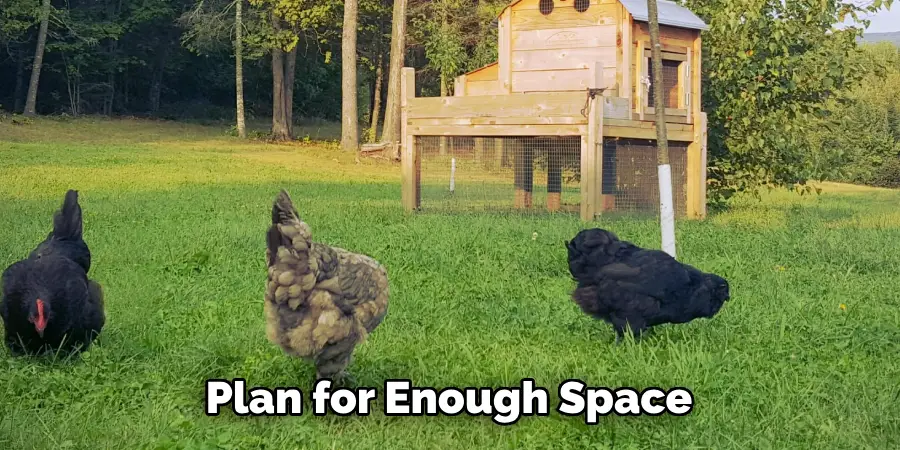
Step 2: Choose the Right Material
The best material to use for chicken perches is natural wood. You can either purchase wooden boards or branches from a home improvement store or use ones you find in nature. Avoid using pressure-treated wood as it may contain harmful chemicals.
Step 3: Cut the Wood
Using a saw, cut the wood to your desired length. The perches should be at least 2-3 inches wide for chickens to comfortably grip onto. If using branches, try to find ones with varying diameters for added grip and comfort for your chickens.
Step 4: Sand Down Rough Edges
To prevent any injuries to your chickens, sand down any rough edges on the perches. You can also use a router or file to smooth out the edges. Also, make sure there are no splinters that can harm your birds.
Step 5: Mark the Placement of Perches
Using a pencil, mark where you want to place the perches inside the coop. Remember to leave enough space between each perch for chickens to comfortably roost without overcrowding each other. However, try to place perches close together as chickens prefer to roost in groups.
Step 6: Drill Pilot Holes (optional)
For added stability, you can drill pilot holes into the coop walls where the perches will be placed. This will make it easier to screw or nail the perches onto the wall securely. As an alternative, you can also use brackets to hold the perches in place.
Step 7: Attach the Perches
Using screws or nails, attach the perches into place. If using screws, make sure they are long enough to go through both the perch and the coop wall. If using nails, make sure they are firmly hammered in for added stability.
Step 8: Add a Variance in Height
Chickens prefer to roost at different heights, so try to vary the height of your perches. This will also help prevent any dominant chickens from claiming all the high spots and leaving others with less desirable spots.
Step 9: Consider Adding a Ladder
Some chicken breeds, such as bantams, may have trouble jumping onto high perches. Consider adding a small ladder or ramp to help them access the higher perches. Even chickens that are able to jump may appreciate the added convenience of a ladder.
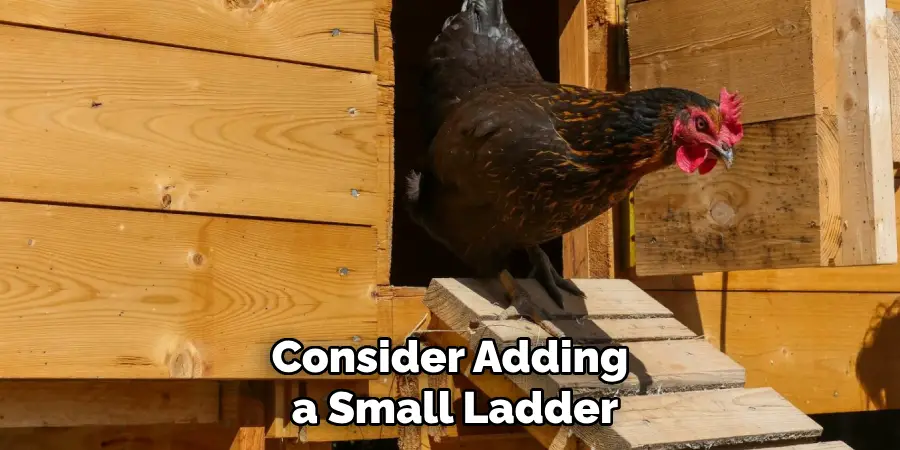
Step 10: Clean or Replace Perches Regularly
Just like any other part of your coop, perches can become dirty and worn over time. Make sure to regularly clean them with a disinfectant solution and replace them if they become too worn out. If using branches, you may need to replace them more frequently.
Step 11: Consider Adding a Droppings Board
To make cleaning your coop even easier, consider adding a droppings board underneath the perches. This will catch most of the droppings and can easily be removed and cleaned. Then, simply add fresh bedding to the coop floor.
Step 12: Monitor and Adjust as Needed
Observe your chickens’ behavior and make adjustments to the perches if needed. For example, if you notice some chickens are struggling to access the higher perches, consider adding additional lower perches for them to use.
Providing suitable perches for your chickens is an important aspect of raising them. By following these steps on how to make perches for chickens, you can create comfortable and safe perches for your feathered friends to roost on at night. Remember to regularly clean and maintain the perches for the health and well-being of your chickens.
9 Safety Measures to Keep in Mind
1) Always Wear Protective Gear
When using tools and handling wood, make sure to wear appropriate safety gear, such as goggles and gloves. This will protect you from any potential injuries. Also, make sure to properly store tools and materials when not in use.
2) Avoid Using Pressure-Treated Wood
As mentioned earlier, avoid using pressure-treated wood as it may contain harmful chemicals. Stick to natural or untreated wood for your chicken perches. Keep in mind that chickens may peck at the wood, so it’s important to use safe materials.
3) Use Proper Tools
Make sure to use tools specifically designed for woodworking. This will ensure safer and more accurate cuts. Also, make sure to read and follow the instructions for any power tools you may be using. If unsure, seek assistance from a professional.
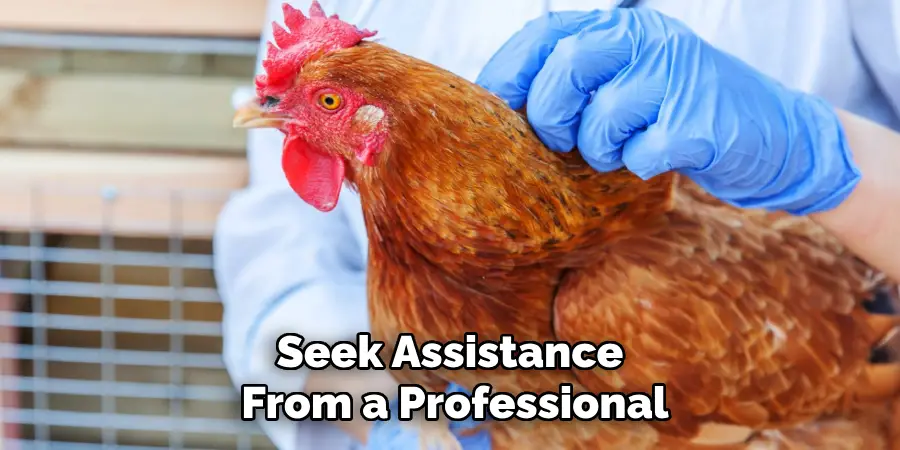
4) Check for Sturdiness
Once the perches are installed, make sure to check their sturdiness before allowing your chickens to use them. If they feel wobbly or unstable, reinforce them with additional screws or nails. Sooner or later, chickens will jump and roost on the perches, so it’s important to ensure they are securely in place.
5) Avoid Overcrowding
As mentioned earlier, make sure to provide enough space for your chickens to comfortably roost without overcrowding each other. Overcrowding can lead to injuries and discomfort for your birds. If adding more chickens to your flock, make sure to add more perches as well.
6) Clean and Disinfect Regularly
Keeping a clean coop is essential for the health of your chickens. Make sure to clean and disinfect the perches regularly along with the rest of the coop. This will help prevent any potential diseases or parasites from spreading.
7) Monitor for Wear and Tear
Regularly check the perches for any signs of wear and tear. Replace them as needed to prevent injuries to your chickens. Wooden perches may also need to be replaced more frequently than metal or plastic ones.
8) Consider Adding Padding
To provide extra comfort for your chickens, consider adding padding to the perches. This can be in the form of old towels, blankets, or specifically designed perch pads. This will also help prevent any injuries from rough edges.
9) Supervise Chickens
When introducing new perches to your coop, it’s important to supervise your chickens and monitor their behavior. Some chickens may take some time to adjust to the new perches, so make sure they are using them properly and safely. Overall, providing safe and comfortable perches for your chickens is an important part of keeping them happy and healthy. By following these safety measures on how to make perches for chickens, you can ensure a safe roosting area for your feathered friends.
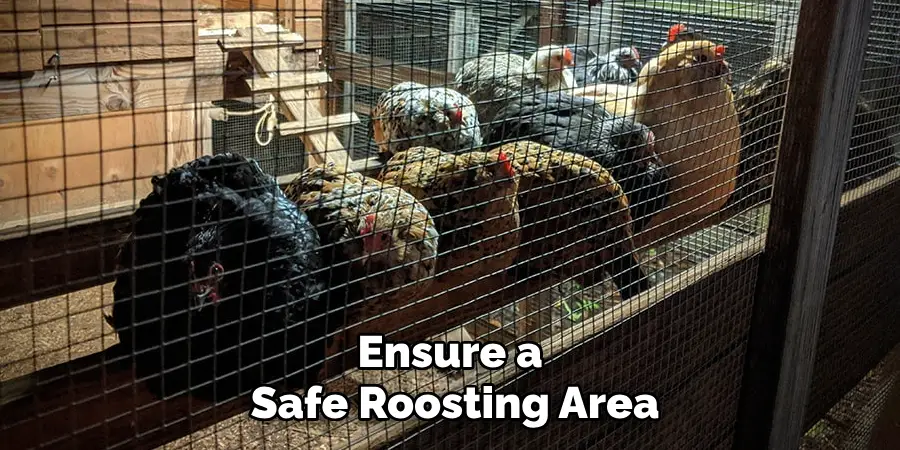
8 Things to Avoid
1) Sharp Edges
When constructing or choosing perches, make sure to avoid any sharp edges or splinters that can harm your chickens. Sand down any rough edges and regularly check for any signs of wear and tear. If using branches, make sure to remove any sharp twigs.
2) Unstable Materials
Avoid using unstable materials for perches, such as small or thin branches that may break easily. This can lead to injuries for your chickens. Stick to sturdy and safe materials like thick wooden dowels or metal rods.
3) Uneven Surfaces
Perches with uneven surfaces can be uncomfortable for chickens and may also cause injuries. Make sure to sand down any bumps or rough areas on wooden perches. For plastic or metal perches, check for any sharp edges.
4) Overly High Perches
While it’s important to provide varying heights for your chickens to roost on, avoid making the highest perch too high. Chickens may injure themselves if they fall from a great height or struggle to fly up to the perch.
5) Overcrowding
As mentioned earlier, overcrowding can lead to injuries and discomfort for your chickens. Make sure to provide enough space for each chicken to roost comfortably without being too close to each other. Evenly, space out the perches throughout the coop.
6) Lack of Cleaning
Neglecting to clean and maintain the perches can lead to a buildup of droppings, bacteria, and parasites. This can be harmful to your chickens’ health. Regular cleaning and disinfecting is important for the well-being of your flock.
7) Toxic Materials
Avoid using toxic materials for your perches, such as certain paints or finishes that may contain harmful chemicals. Stick to safe and natural materials. Also, avoid using old or moldy bedding for the coop floor.
8) Unsecured Perches
Make sure all perches are securely attached to the walls of the coop and can withstand the weight of multiple chickens. Unsecured perches can easily fall and cause injuries to your birds. Regularly check for any loose screws or nails and reinforce as needed.

By considering these safety measures on how to make perches for chickens and avoiding potential hazards, you can ensure a safe and comfortable roosting area for your chickens.
Remember to clean and maintain the perches regularly to keep them in good condition. Your chickens will appreciate having a safe and comfortable place to roost, and you’ll have peace of mind knowing they are well taken care of.
8 Additional Tips
1) Provide Multiple Perches
It’s a good idea to provide multiple perches in the coop to allow for more space and variety for your chickens. This also prevents dominance issues among flock members vying for a single perch. If possible, try to provide perches at different heights for your chickens to choose from.
2) Consider Different Types of Perches
In addition to wooden perches, consider adding other types of perches, such as rope or PVC pipe. This allows for a more diverse and interesting roosting area for your chickens. Like with wooden perches, make sure to regularly check for any signs of wear and tear.
3) Cater to Different Sizes
Chickens come in different sizes, so it’s important to provide perches that can accommodate all of them. Consider varying the thickness and length of your perches to cater to smaller or larger chickens. This will also prevent overcrowding on a single perch.
4) Provide Different Textures
Perches with different textures can provide stimulation and exercise for your chickens’ feet. Consider adding sandpaper or textured grip tape to some of the perches. This also helps them to file down their nails naturally.
5) Rotate Perches
To prevent wear on a single perch, switch out the location of perches or rotate them with other perches in the coop. This also allows for a change in scenery and prevents boredom for your chickens.
6) Use Natural Branches
If possible, use natural branches as perches instead of store-bought dowels. Not only do they provide texture and stimulation for your chickens’ feet, but they also add a more natural and rustic feel to the coop.
7) Add Perches Near Windows
Chickens enjoy basking in the sun, so consider placing some perches near windows or skylights in your coop. This will also provide natural light and ventilation for the coop. If your chickens are free-ranging, place perches near favorite spots for them to perch and watch the outside world.

8) Consider Perch Placement
When placing perches in the coop, make sure they are not directly above food or water sources. This prevents droppings from contaminating their food and water. Also, avoid placing perches too close to nesting boxes to prevent chickens from sleeping in them and soiling the eggs.
By implementing these additional tips, you can provide a more enriching and comfortable environment for your chickens to roost in. Experiment with different perches to see what your flock prefers. Remember, a happy and healthy chicken makes for a happy and satisfied owner. So enjoy watching your feathered friends roost and relax on their perches.
Frequently Asked Questions
How Many Perches Do I Need in My Coop?
It’s recommended to have at least one foot of perch space per chicken. This can vary depending on the size and breed of your chickens, but it’s always better to provide more rather than less.
Can I Use Tree Branches as Perches?
Yes, you can use tree branches as perches. Just make sure to properly clean and disinfect them before placing them in the coop. Avoid using branches from trees that are toxic to chickens, such as yew or cedar.
Should I Provide Different Types of Perches for My Chickens?
Yes, it’s beneficial to provide different types of perches for your chickens. This allows for more variety and stimulation for their feet. It also prevents boredom and dominance issues among flock members.
How Often Should I Clean the Perches?
It’s recommended that the perches be cleaned at least once a week. However, if you notice excessive droppings or signs of mold or parasites, clean the perches immediately.
Can I Use Perches for Other Birds, Such as Ducks or Geese?
Perches are mainly used by chickens and other similar-sized birds. Ducks and geese do not typically use perches to roost and may prefer bedding on the floor instead. However, you can still provide perches for them to use if they choose to.
What If My Chickens Don’t Use the Perches?
Some chickens may not roost on perches and prefer sleeping on the floor of the coop instead. As long as your chickens are healthy and comfortable, this is perfectly fine. However, if you notice any injuries or signs of discomfort from sleeping on the floor, consider providing additional or different types of perches.
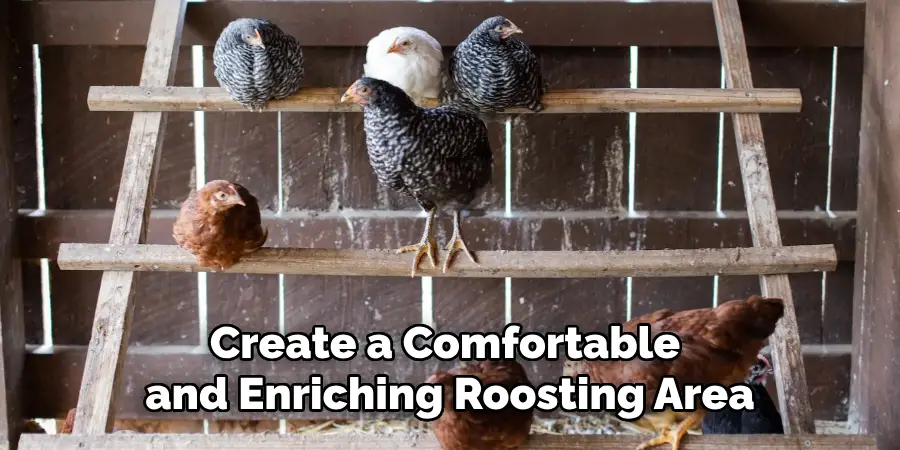
Perches are an essential and important feature in a chicken coop for the health and well-being of your flock. By following safety measures and implementing these additional tips, you can create a comfortable and enriching roosting area for your chickens.
Conclusion
In this guide, we have discussed the importance of perches in a chicken coop and how to make perches for chickens and maintain them. We also provided additional tips on how to enhance your chickens’ roosting experience by providing different types, sizes, and textures of perches. Remember to regularly clean and rotate perches for optimal use.
So go ahead and give yourself a pat on the back for being an awesome chicken owner who cares about every aspect of their wellbeing.
About
Outdoor Fixes is a distinguished figure in the world of Diy design, with a decade of expertise creating innovative and sustainable Diy solutions.
His professional focus lies in merging traditional craftsmanship with modern manufacturing techniques,
fostering designs that are both practical and environmentally conscious. As the author of diy,
outdoorfixes delves into the art and science of outdoorfixes-making, inspiring artisans and industry professionals alike.
Education RMIT University
(Melbourne, Australia) Associate Degree in Design (Outdoor Fixes) Focus on sustainable design, industry-driven projects,
and practical craftsmanship. Gained hands-on experience with traditional and digital manufacturing tools, such as CAD and CNC software.
Nottingham Trent University
(United Kingdom) Bachelor’s in outdoorfixes.com and Product Design (Honors) Specialized in product design with a focus on blending creativity with production
techniques. Participated in industry projects, working with companies like John Lewis and Vitsoe to gain real-world insights.
Publications and Impact
In diy, Outdoor Fixes his insights on indoor design processes, materials, and strategies for efficient production.
His writing bridges the gap between artisan knowledge and modern industry needs, making it a must-read for both budding designers and seasoned professionals.

